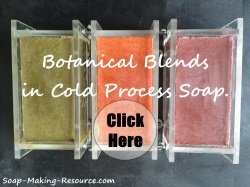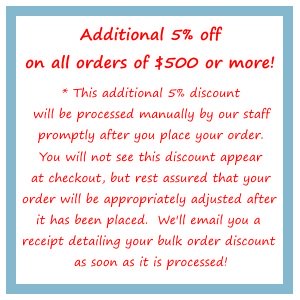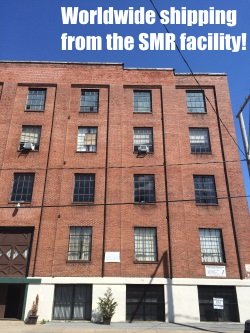Goat's Milk Soap Recipe
On this page, I will explain how to make my all-time favorite goat's milk soap recipe. Within this tutorial, I am going to explain my exact method for making goat's milk soap. Making goat's milk soap can be a bit tricky, but if you follow the below steps, you should find success very easily! Are you a visual learner? This tutorial comes complete with pictures for each step.
I will be describing not just my method for making goat's milk soap, but also a full goat's milk soap recipe formula along with the essential oil blend that I used for this batch.
Goat's milk has plenty of extra vitamins and proteins that are great for the skin. Soap made with goat's milk will turn out very creamy and have a great lather. You will notice the difference in your bar right away!
This goat's milk soap recipe will make a 5 pound batch of soap and will fit perfectly into our 5 pound acrylic log mold, 5 pound acrylic slab mold or 5lb wooden log mold. For goat's milk soap, I usually recommend using an acrylic soap mold simply because it does not insulate as well as wood. Remember, for goat's milk soap, we want to keep our batch as cool as possible, so a non-insulating mold is preferable!
Below is a pictured of our finished goat's milk soap. As you can see, it turned out to have a beautiful creamy white hue as we used a method to prevent discoloration and darkening that can easily occur when making a goat's milk soap recipe.
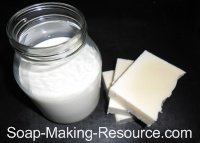
Get the Kit! (Out of Stock)
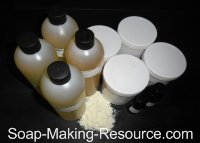
Soap Making Resource is now offering this goat's milk soap recipe in a kit. Within this kit, you will receive 32 ounces of olive oil, 13.5 ounces of palm kernel oil, 16 ounces of rice bran oil, 13.5 ounces of coconut oil, 13.5 ounces of shea butter, 13.5 ounces of palm oil (RBD), 16 ounces of castor oil, 1 ounce of eucalyptus essential oil, 2 ounces of spearmint essential oil and 2.5 ounces of goat's milk powder.
This goat's milk soap recipe kit will include more than enough ingredients to make a 5 pound batch of our goat's milk soap as described within this tutorial, plus you will have plenty of leftover supplies for future soap making projects!
As with all of our cold process soap making kits you will have to provide the lye and distilled water to complete this batch. Lye can be purchased at many local hardware stores and distilled water, of course, can be purchased in most grocery stores. Within this kit, we will provide you with contact information for our personal lye source, just in case you can't find any locally. This information alone is a fabulous value!
I recommend that along with your goat's milk soap recipe kit that you also purchase one of Soap Making Resource's 5 pound no-line acrylic log soap molds. It will work perfectly with this batch!
Finally, don't forget that all soap making kits come complete with full written instructions so you can follow along step by step as you make the batch.
Goat's Milk Soap Recipe Kit: $60.44 Out of Stock
Keep in mind that all ingredients are also available to purchase in bulk at soap-making-resource.com
Here is the exact goat's milk soap recipe formula that we will be using:
- Olive Oil = 26.5 Ounces (50% of total oils)
- Palm Kernel Oil = 5.3 Ounces (10% of total oils)
- Rice Bran Oil = 5.3 Ounces (10% of total oils)
- Coconut Oil (76 degrees) = 5.3 Ounces (10% of total oils)
- Shea Butter (Unrefined) = 5.3 Ounces (10% of total oils)
- Palm Oil (RBD) = 2.65 Ounces (5% of total oils)
- Castor Oil = 2.65 Ounces (5% of total oils)
- Eucalyptus Essential Oil = 28 Grams (.988 Ounces)
- Spearmint Essential Oil = 52 Grams (1.834 Ounces)
- Goat's Milk = 20 ounces
- lye = 7.185 ounces (203 grams)
*This recipe has a 5% super-fat.
*All measurements are weight measurements, not liquid measurements.
The key to making goat's milk soap successfully is to keep your batch cool at all times. If the batch is allowed to heat up too much, it will overheat causing your soap to have an undesirable smell and turn a dark brown hue. If allowed to overheat to an extreme degree, you can even experience a "soap volcano" which will cause your soap batch to rise up out of your mold and spill all over. Don't worry though... this only happens if the heat is really allowed to build up substantially! If you carefully follow my steps below, you should be just fine!
Here is the step by step process for completing my goat's milk soap recipe.
Step 1) First, we are going to create our lye solution. For this goat's milk soap recipe, keep in mind that we will be replacing 100% of our water content with Goat's milk. So, we are actually going to be making our lye solution by dissolving the lye into our goat's milk rather than into water.
There is a very specific way to make a goat's milk lye solution, so make sure that you follow the below method.
First of all, the goat's milk that we use in our recipe must be frozen, so remember to do this the day before! You can put your goat's milk in a zip-lock bag and freeze it, or you can fill a couple of ice cube trays with goat's milk and freeze it. Up to you!
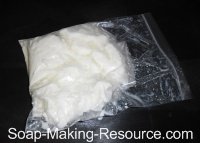
If you are not able to get your hands on fresh goat's milk, you can use canned or powdered goat's milk for soap making. Keep in mind though that canned goat's milk is usually condensed, so you may have to add some water to it for dilution. Similarly, when using powdered goat's milk, you have to find out from the manufacturer what the concentration strength of the powder is so that you know how much water to use to dilute it. With both canned and powdered milk, always remember to use distilled water when diluting as you should only use distilled water when making soap!
When creating our lye solution, have a bowl filled with ice water on hand and ready to use.
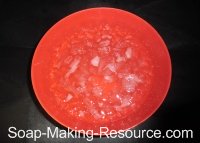
Next, measure out the necessary amount of goat's milk. My goat's milk soap recipe calls for 20 ounces. As you can see in the picture below, I am breaking off my frozen goat's milk and weighing it out into a plastic container. Allow your goat's milk to set until it has melted to a slush form.
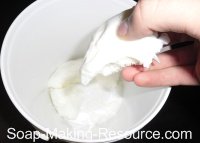
Now measure out your dry lye. For this batch, we need 203 grams of lye. Always measure out your lye in grams as this smaller unit of measurement is a lot more accurate.
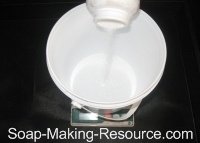
Next, before you pour the lye into the goat's milk, submerge the container that is holding your goat's milk slush into the ice water. This will help keep the milk cool as we pour in our powdered lye. The heat produced from adding the lye will melt the goat's milk the rest of the way.
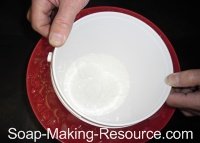
Pour a small amount of lye, about 1/10 of your measured out portion, into the goat's milk and stir it in using your silicone spatula.
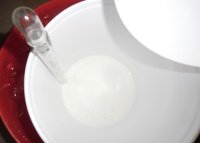
Next, we are going to take the temperature of our milk. If the temperature is below 100 degrees, you can pour in another small portion of lye and stir it in again.
Why are we adding our lye gradually like this? If you pour in all the lye all at once, there is a very good chance that your solution will overheat, causing the milk to turn a dark orange hue and have an undesirable smell.
After you pour in each small portion of lye, take the temperature of your milk. If the temperature is below 100 degrees, you can mix in another small portion of lye. If it is above 100 degrees, stop for a while and allow the milk to cool. Repeat these steps until all of your lye is mixed into the goat's milk. This method will ensure that your milk does not overheat!
Keep in mind that as you mix in your lye, you may start to see the saponification reaction start to occur as goat's milk does have some fat in it.
After all the lye is added to your goat's milk, remove it from the ice bath and set it safely off to the side. Be sure to monitor the solution though as you will have to insert it back into the ice water if heat starts to build. Once all the lye is added in this gradual manner, your temperature should be pretty stable and probably won't build up anymore.
Step 2) Next, measure out the soap making oils needed for your goat's milk soap recipe batch and melt them down. You should measure out the oils in your stainless steel soap pot. Our goat's milk soap recipe as explained above calls for 26.5 ounces of olive oil, 5.3 ounces of palm kernel oil, 5.3 ounces of rice bran oil, 5.3 ounces of coconut oil, 5.3 ounces of shea butter, 2.65 ounces of palm oil and 2.65 ounces of castor oil. Remember that these measurements are weight ounces, not liquid ounces! Weigh everything out as accurately as possible.
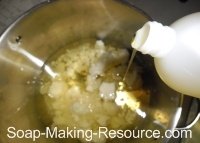
Once all of your oils are weighed out, place your soap pot on an oven burner set to a low temperature. It is really important that you make sure your oven burner is set very low as you don't want to overheat your oils!
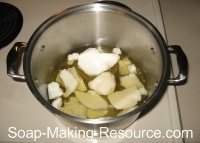
Step 3) Next, we are going to prepare our goat's milk soap recipe additives while we wait for our oils to melt. For this goat's milk soap recipe we will be creating an essential oil blend of spearmint essential oil and eucalyptus essential oil.
Measure out in separate containers 52 grams of spearmint essential oil and 28 grams of eucalyptus essential oil.
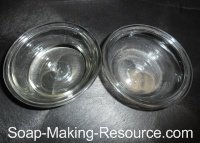
Once all your essential oils are accurately measured out, combine them all into one dish
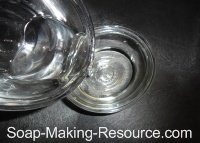
Why exactly did I measure out each essential oil separately? Well, if you make a mistake in measuring and accidentally pour out too much, you can always pull some of the essential oil out of its specific dish using a pipette. If you are measuring out your essential oils for a blend into other essential oils, and you make a mistake, there is nothing you can do about it! So, I personally like to measure out each essential oil separately and then combine them all into one dish.
Step 4) by now your oils should be melted. Remove your soap pot from the burner and set a thermometer into the mixture of oils. We need to cool down our oils to about 80 degrees to 90 degrees Fahrenheit or lower. Especially for this goat's milk soap recipe, it is vital to soap cool!
You can cool your oils down by placing the stainless steel pot into ice water. At this point, you should also check the temperature of your lye solution. It too should be around 80 degrees to 90 degrees Fahrenheit or less. If needed, you can cool the lye solution down using the same ice bath method.
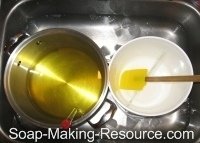
Step 5) At this point, our goat's milk lye solution and oils mixture are at our desired temperature and the essential oil blend is ready to be added to our batch when the time is right. We are finally ready to make soap!
Slowly pour your goat's milk lye solution into the soap making oils, stirring manually at first.
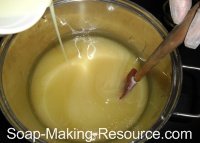
After your lye solution is initially mixed into the oils and you have an even texture and color, begin using your stick blender to stir more thoroughly.
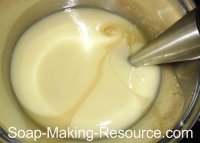
Keep on mixing until you reach a light trace. You can test for trace by dribbling a small portion of "soap batter" onto the surface of the rest of your batch and if it settles on top for a brief period before sinking back into the rest of the mixture, you have reached trace successfully. At this point, your soap should be the consistency of a very thin pudding.
Now that your soap has reached a light trace, stir in your essential oil blend. Doesn't it smell wonderful!
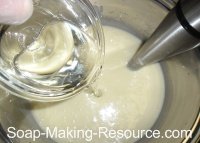
Keep mixing until your soap has an even texture and color.
Step 6) Now that your soap is thoroughly mixed, pour it into your soap mold.
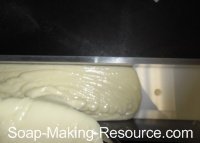
I really do recommend that for a goat's milk soap recipe you use an acrylic mold. Wood insulates very well; therefore, if you are using a wooden mold it may be hard to keep the heat from building and ultimately discoloring your finished product. If you must use a wooden mold, you may want to stick your goat's milk soap recipe batch in the freezer immediately after pouring the soap into your mold to keep the temperature down. Of course, do not insulate with towels for this batch!
If you want to, you can even pile ice around your acrylic soap mold to help keep the temperature down as even with acrylic molds, you still need to be careful that the heat from the reaction doesn't build. It is much easier though to control the temperature when you are using an acrylic mold as you don't have to worry about your soap being overly insulated.
Step 7) After 24 hours, or once your soap has solidified, you can remove it from the mold. As you can see in the picture below, I am removing my log of soap from my Soap Making Resource acrylic log mold by pushing it out with the pusher stands. It works very nicely!
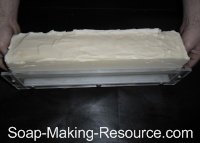
Step 8) For perfect bars, cut your soap using the Soap Making Resource guided soap cutter.
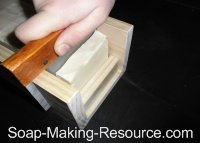
Step 9) Lay your soap on a drying rack and let it cure for 6 - 8 weeks. This will allow any excess liquid to evaporate from the soap causing your finished product to be a hard and long lasting bar with a great lather.
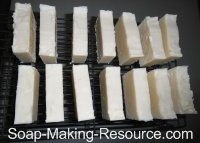
Step 10) Enjoy your all natural homemade goat's milk soap!
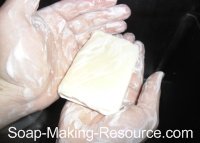
I hope that you all enjoyed my goat's milk soap recipe tutorial. Hopefully this will be a go-to formula for you all! Don't forget that all of the ingredients used in this tutorial (except for the fresh goat's milk of course) can be picked up right here at soap-making-resource.com.
Alternately, you can get the kit which will include all the ingredients you need to make this goat's milk soap recipe, aside from the lye and distilled water, along with full written instructions for completing the batch. Keep in mind that distilled water can be purchased at most grocery stores and lye can be bought at many local hardware stores. Of course, all of our soap making kits include contact information for my personal lye source, just in case you can't find any locally!
Return from the goat's milk soap recipe to the soap recipes hub page.

